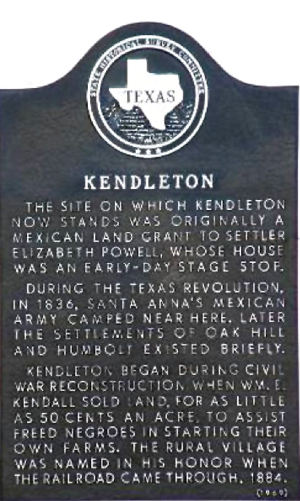
Lawyer and land agent William Kendall.
By Joan Frances –
Fort Bend County encompasses approximately 886 square miles, over 562,560 acres of varied terrain from level to gently rolling. Cottonwood, ash, oak and pecan trees are native to the area. Land is prosperous with 11 square miles of small lakes, creeks and rivers. Three floatable, permanent waterways, the Brazos, San Bernard and Oyster Creek Rivers, contribute to fertile soil and successful farming.
Fort Bend is included in the top ten fastest growing counties in the United States. There are 17 incorporated cities impacting progress, forever reflective of the past and contributing to the future. One of the oldest areas dating back to 1819 with opulent history is the city of Kendleton.
Due east of the San Bernard River, Kendleton is located 26 miles south of Sugar Land on Highway 59. Because of the convenient location to the river, this area was appealing to Elizabeth Powell, considered to be the “Yellow Rose of Texas,” and her Jamaican husband. Her husband was a survivor of a shipwreck during the Mexican American War. During the late 1820s, they walked to Texas from Mexico and settled near the San Bernard River with a land grant from Mexico. Here she raised four children and built an early American double pen or dog run house, which is a house with two rooms separated by a hallway open at both ends.

The Texas Historical Commission plaque in Kendleton.
Madame Powell, as Elizabeth Powell was known, also helped fleeing slaves by allowing them safe passage on her stagecoach. Travelers began staying at her home; she accommodated William B. Travis and Anson Jones and set up a resting camp for Santa Anna and his military troops before they traveled to Harrisburg. On April 26, 1836, when the Army began moving out, they burned the home and outbuildings. Elizabeth was one of the first Texans to place a claim with the government for losses incurred during the war. She later sold the land to her neighbor. The Powell Point School, named in her honor, was built in the 1890s on her land grant and later moved to a nearby settlement, eventually becoming a part of the Kendleton Independent School District.
William E. Kendall, a lawyer and land agent, purchased a large plantation in the 1830s. After the Civil War, Kendall divided the land into 100 acre plots and sold them to freed African Americans at a price of fifty cents to one dollar an acre. Smaller plots of 25 to 60 acres were also sold. Many emancipated slaves came to buy land with the intention of farming cotton, corn, rice and sugarcane as free men. The land is still owned by many of the descendants of these former slaves.
This community was named Kendleton in honor of William Kendall’s compassion and generosity. To facilitate growth in 1884, the Texas, New York and Mexican Railway Company built tracks between Rosenberg and Victoria, passing through Kendleton. Soon after, a post office and general store was established and commerce continued.
On May 2, 1939, hundreds of people witnessed a meteorite fireball over the sky in Houston, crossing over 44 miles and landing in Kendleton. The public was terrified and feared the end of the world as it plummeted to earth. By scientific calculations and photographs of the trail, astronomers traveled to this small community to study the terrain and discovered 13 complete stones and 15 fragments from around the area. Suitably, the meteorite was named “Kendleton.”
The community became incorporated in 1973, and the population increased to over 600. Fluctuating through the years, census in 2012 recorded 385 residents although over 2,000 live in the area. Kendleton is an example of the actions of others that contribute to the good of man, yet another standard of the deep roots of Fort Bend County.